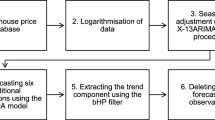Abstract
In this article, we examine linkages across non-energy commodity price developments by means of a factor-augmented VAR model (FAVAR). From a set of non-energy commodity price series, we extract two factors, which we identify as common trends in metals and food prices. These factors are included in a FAVAR model together with selected macroeconomic variables, which have been associated with developments in commodity prices. Impulse response functions confirm that exchange rates and economic activity affect individual non-energy commodity prices, but we fail to find strong spillovers from oil to non-oil commodity prices or an impact of the interest rate. In addition, we find that individual commodity prices are affected by common trends captured by the food and metals factors.
Similar content being viewed by others
References
Akram QF (2009) Commodity prices, interest rates and the dollar. Energy Econ 31: 838–851
Anzuini A., Pagano P, Pisani M (2007) Oil supply news in a VAR: information from financial markets. Banca d’Italia Temi di Discussione no. 632
Anzuini A, Lombardi MJ, Pagano P (2010) The impact of monetary policy shocks on commodity prices. ECB working paper no. 1232
Baffes J (2007) Oil spills on other commodities. Resour Policy 32: 126–134
Bai J, Ng S (2006) Confidence intervals for diffusion index forecasts with a large number of predictors and inference for factor-augmented regressions. Econometrica 74: 1133–1150
Banbura M, Giannone D, Reichlin L (2010) Large Bayesian vector autoregressions. J Appl Econom 25: 71–79
Banerjee A, Marcellino M (2008) Factor-augmented error correction models. CEPR discussion paper 6707
Bernanke BS, Boivin J, Eliasz P (2005) Measuring the effects of monetary policy: a factor-augmented vector autoregressive (FAVAR) approach. Q J Econ 120: 387–422
Boschi M, Pieroni L (2009) Aluminium market and the macroeconomy. J Policy Model 31: 189–207
Breitenfellner A, Crespo Cuaresma J (2008) Crude oil prices and the euro-dollar exchange rate: a forecasting exercise. University of Innsbruck working papers in economy and statistics 2008-08
Caballero R, Fahri E, Gourinchas P-O (2008) Financial crash, commodity prices and global imbalances. Brook Pap Econ Act 2: 1–55
Carriero A, Kapetanios G, Marcellino M (2011) Forecasting large datasets with Bayesian reduced rank multivariate models. J Appl Econ 26: 735–761
Chaudhuri K (2001) Long-run prices of primary commodities and oil prices. Appl Econ 33: 531–538
De Mol C, Giannone D, Reichlin L (2008) Forecasting using a large number of predictors: is Bayesian regression a valid alternative to principal components?. J Econom 146: 318–328
Frankel JA (2008) The effect of monetary policy on real commodity prices. In: Campbell JY Asset prices and monetary policy. NBER Books, Cambridge, pp 291–333
International Monetary Fund (2006) The boom in nonfuel commodity prices—can it last? In: World economic outlook, September 2006. IMF, Washington DC, pp 139–169
Johansen S (2000) A Bartlett correction factor for tests on the cointegration relations. Econom Theory 16: 740–778
Kilian L (1998) Small-sample confidence intervals for impulse response functions. Rev Econ Stat 80: 218–230
Kilian L (2008) Exogenous oil supply shocks: how big are they and how much do they matter for the U.S. economy?. Rev Econ Stat 90: 216–240
Kilian L (2009) Not all oil price shocks are alike: disentangling demand and supply shocks in the crude oil market. Am Econ Rev 99: 1053–1069
Kose A, Otrok C, Whiteman CH (2004) International business cycles: world, region, and country-specific factors. Am Econ Rev 93: 1216–1239
Labys WC (2006) Modeling and forecasting primary commodity prices. Ashgate Publishing, Aldershot
Masters MW (2008) Testimony before the committee on homeland security and governmental affairs. United States Senate, May 20
Mitchell D (2008) A note on rising food prices. World Bank Policy Research working paper no. 4682
Pindyck RS, Rotemberg JJ (1990) The excess co-movement of commodity prices. Econ J 100: 1173–1189
Redrado M, Carrera J, Bastourre D, Ibarlucia J (2009) Financialization of commodity markets: non-linear consequences form heterogeneous agents behavior. Banco Central de la Republica Argentina working paper no. 2009|44
Reitz S, Slopek U (2009) Non-linear oil price dynamics—a tale of heterogeneous speculators?. Ger Econ Rev 10: 270–283
Stock J, Watson M (2002) Macroeconomic forecasting using diffusion indexes. J Bus Econ Stat 20: 147–162
Vansteenkiste I (2008) How important are common factors in driving non-fuel commodity prices? A dynamic factor analysis. ECB working paper no. 1072
World Bank (2008) Global economic prospects, January 2008. World Bank, Washington DC
Author information
Authors and Affiliations
Corresponding author
Rights and permissions
About this article
Cite this article
Lombardi, M.J., Osbat, C. & Schnatz, B. Global commodity cycles and linkages: a FAVAR approach. Empir Econ 43, 651–670 (2012). https://doi.org/10.1007/s00181-011-0494-8
Received:
Accepted:
Published:
Issue Date:
DOI: https://doi.org/10.1007/s00181-011-0494-8




